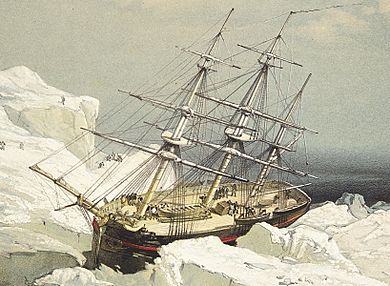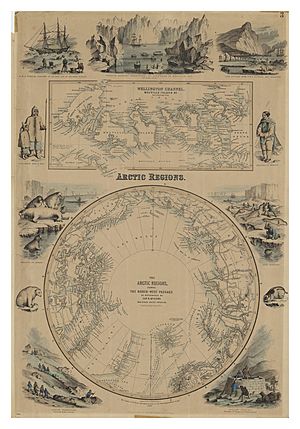Robert McClure facts for kids
Quick facts for kids
Sir
Robert McClure
|
|
|---|---|
 |
|
| Birth name | Robert John Le Mesurier McClure |
| Born | 28 January 1807 Wexford, Wexford, Ireland |
| Died | 17 October 1873 (aged 66) Portsmouth, Hampshire, UK |
| Resting place |
Kensal Green Cemetery
|
| Branch | |
| Service years | 1824–1873 |
|
Academy
|
|
| Rank | Vice-admiral |
| Wars | Second Opium War |
|
Expeditions
|
|
| Awards |
|
| Spouse(s) |
Constance Tudor (m. 1869)
|
| Relations | John Elgee (grandfather) |
Sir Robert John Le Mesurier McClure (born January 28, 1807, died October 17, 1873) was an Irish explorer. He became famous for exploring the Arctic. In 1854, he traveled through the Northwest Passage by boat and sledge. He was also the first person to sail all the way around North and South America.
Contents
Robert McClure was born in Wexford, a town in the southeast of Ireland. His father, Captain Robert McClure, was a soldier who died before Robert was born. Robert spent his childhood with his godfather, John Le Mesurier. John was the governor of Alderney, a small island. He made sure Robert got a good education.
In 1824, Robert McClure joined the Royal Navy. This was the start of his career at sea. Twelve years later, in 1836, he got his first chance to explore the Arctic. He served as a mate on a ship called HMS Terror. This expedition was led by Captain George Back.
After this trip, McClure became a lieutenant. From 1838 to 1839, he worked on the Great Lakes in Canada. Later, he served at naval stations in North America and the West Indies until 1846.
In 1848, McClure joined a search party. They were looking for Franklin's lost expedition. This was a group of explorers led by Sir John Franklin who had gone missing in the Arctic in 1845. McClure served as the first lieutenant on HMS Enterprise, under Captain James Clark Ross.
Exploring the Northwest Passage
After returning from the first search for Franklin, McClure joined a new expedition in 1850. He was given command of HMS Investigator. Another ship, HMS Enterprise, was commanded by Richard Collinson. The two ships sailed south through the Atlantic Ocean. They went around the tip of South America through the Strait of Magellan. A steam-powered ship, HMS Gorgon, helped them. Collinson and McClure's ships got separated and did not meet again during their journeys.
The Investigator sailed north through the Pacific Ocean. It entered the Arctic Ocean by going through the Bering Strait. McClure's goal was to sail east past Point Barrow, Alaska. He hoped to meet another British expedition coming from the east.

In the spring of 1853, the Investigator became stuck in thick ice. McClure and his crew had to leave their ship. They started a long journey by sledge (a type of sled). Luckily, they met a group from HMS Resolute. This ship was part of an expedition led by Sir Edward Belcher, who had sailed into the Arctic from the east. McClure and his crew were rescued. This rescue meant McClure had completed his journey across the Northwest Passage. The Resolute also got stuck in the ice that year and was abandoned. However, it was later found and recovered.
Because of this journey, McClure and his crew were the first to do two amazing things:
- They were the first to sail all the way around North and South America.
- They were the first to travel through the Northwest Passage.
When McClure returned to England in 1854, he faced a court-martial. This was a normal process when a captain lost his ship. But McClure was found innocent. He was then made a knight and promoted in rank. He also received £10,000 from the British Parliament as a reward for his special achievements.
McClure was also honored by important geographical societies in England and France. In 1855, he became a member of the American Antiquarian Society.
Later Years and Legacy
From 1856 to 1861, Sir Robert McClure served in eastern waters. He commanded a group of sailors near Canton in 1858. For this service, he received the Order of the Bath.
In his later years, he lived a quiet life in the countryside. He became a rear-admiral in 1867 and a vice-admiral in 1873. He passed away later that same year.
Sir Robert McClure is buried in Kensal Green Cemetery in London. His tombstone has a Latin phrase that means: 'Thus We Launch into this Formidable Frozen Sea. My Hope is in God.'
Two places were named after him:
- The McClure Strait, a waterway in the Arctic.
- The McClure crater on the Moon, located in the Mare Fecunditatis (Sea of Fertility).
See also
 In Spanish: Robert McClure para niños
In Spanish: Robert McClure para niños


